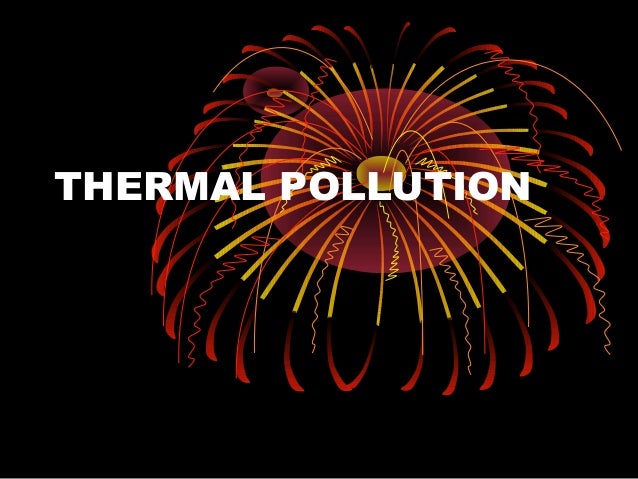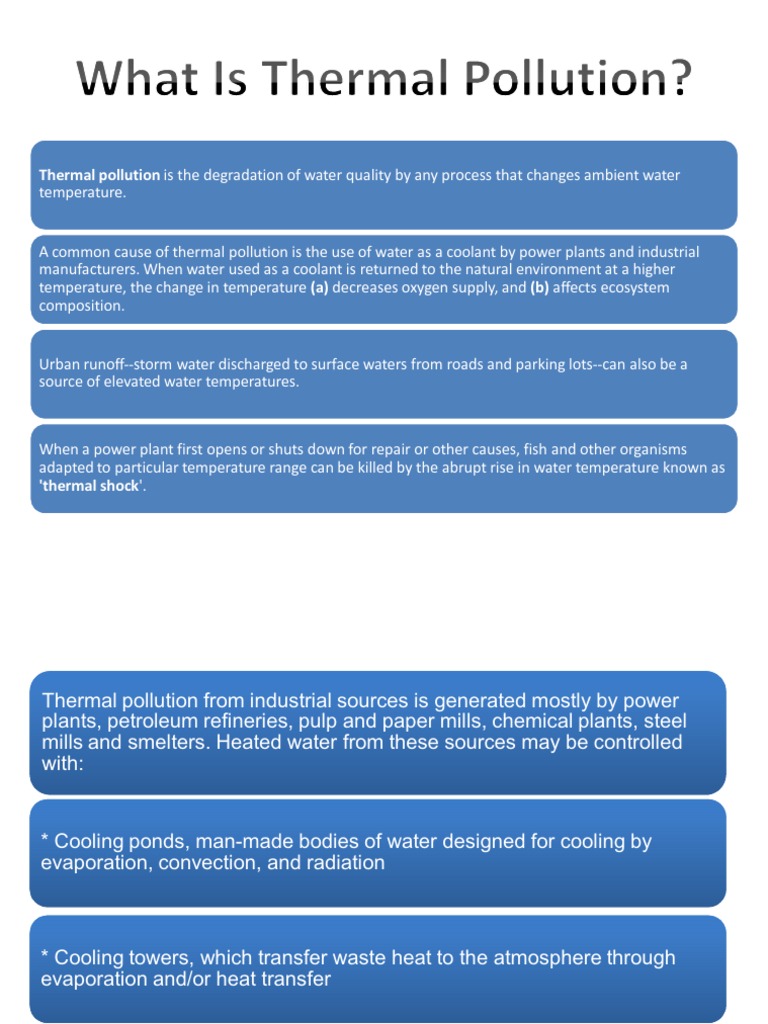- Ppt On Thermal Pollution Worksheets
- Ppt On Thermal Energy
- Thermal Pollution Experiment

Thermal pollution is the degradation of water quality by any process that changes ambient water temperature. A common cause of thermal pollution is the use of water as a coolant by power plants and industrial manufacturers.
Thermal pollution can also lead to significant deviations from the activities of aquatic communities. Thermal pollution is the degradation of water quality by any process that changes the temperature of the ambient water. A common cause of thermal pollution is the use of water as a refrigerant by power plants and industrial manufacturers. Control of thermal pollution 1. Cooling ponds: Heated effluents on the surface of water in cooling ponds maximize dissipation of heat to the atmosphere & minimize the water area & volume. This is the simplest & cheapest method which cools the water to a considerable low temperature. Thermal Pollution (Discharge of warm water into water bodies by factories). Major types of environmental complaints addressed include pollution issues related to. Air, noise, water, solid waste and odour. PowerPoint Presentation Last modified. Ppt for Thermal Insulation Coating Market, 2017 - Thermal Insulation Coating Market Size, Industry Analysis Report, Regional Outlook (U.S., Canada, Germany, UK, Italy, France, Spain. The PowerPoint PPT presentation: 'Thermal Pollution' is the property of its rightful owner. THERMAL POLLUTION PDF and PPT: When the quality of water is degraded as results of modification in close water temperature it’s referred to as Pollution that affects the water quality and that type water termed anomaly for consumption is significantly for drinking purpose. A rise in the optimum water temperature through a method (steel. However, thermal pollution is a real and persistent problem in our modern society. In layman’s terms, thermal pollution is when an industry or other human-made organization takes in water from a natural source and either cools it down or heats it up.
<ul><li><p>THERMAL POLLUTION SRIRAM V LECTURER IN CHEMISTRY KNCET THOTTIAM</p></li><li><p>THERMAL POLLUTION</p></li><li><p>DEFINITION ADDITION OF EXCESS OF UNDESIRABLE HEAT TO WATER THAT MAKES IT HARMFUL TO MAN, ANIMAL OR AQUATIC LIFE</p></li><li><p>CAUSES DISCHARGE OF HEATED WATER OR HOT WASTE MATERIAL INTO WATER BODIES FROMNUCLEAR POWER PLANTSINDUSTRIAL EFFLUENTSDOMESTIC SEWAGEHYDRO-ELECTRIC POWERCOAL FIRED POWER PLANTS</p></li><li><p>NUCLEAR POWER PLANTS</p><p> Nuclear power plants use water as a cooling agent.</p><p> After the water is used, it is put back into a water supply at 9-20oC</p><p> Emissions from nuclear reactor increase the temperature of water bodies.</p></li><li><p>Coal-fired power plants Coal is utilized as a fuel Condenser coils are cooled with water from nearby lake or river The heated effluents decrease the DO of water Damages the marine organisms</p></li><li><p>Industrial Effluents</p><p>Discharged water from steam-electric power industry using turbo generators will have a higher temperature ranging from 6 to 9C than the receiving waterIn modern stations, producing 100 MW, nearly one million gallons are discharged in an hour with increase in temperature of the cooling water passing by 8 to 10 C </p></li><li><p>Domestic sewageSewage is commonly discharged into lakes, canals or streamsMunicipal sewage normally has a higher temperature than the receiving waterIncrease in temperature of the receiving water decreases the DO of water.The foul smelling gases increased in water resulting in death of marine organisms</p></li><li><p>Hydro electric power generationGeneration of hydroelectric power sometimes results in negative thermal loading in water systemsCreates less heat on water sources less than nuclear power plant</p></li><li><p>CONTROL MEASURESCooling towers</p><p>Cooling ponds</p><p>Spray ponds</p><p>Artificial lakes</p></li></ul>
Views 20,806
From Embeds
Number of Embeds
ActionsDownloads
Comments
Likes
Ppt On Thermal Pollution Worksheets
Embeds 0
Ppt On Thermal Energy

Thermal Pollution Experiment
Itis caused by either dumping hot water from factories and power plants or removing trees and vegetation that shade streams, permitting sunlight to raise the temperature of these waters.Like other forms of water pollution, thermal pollution is widespread, affecting many lakes and vast numbers of streams and rivers in the United States and other parts of the world.Urban runoff–storm water discharged to surface waters from roads and parking lots–can also be a source of elevated water temperatures.Left unshaded, the water warms by as much as 10 Celsius degrees (18 Fahrenheit degrees). In a similar manner, grazing sheep and cattle can strip streamsides of low vegetation, including young trees. Muddy water absorbs more energy from the sun than clear water does, resulting in further heating. Finally, water running off of artificial surfaces, such as streets, parking lots, and roofs, is warmer than water running off vegetated land and, thus, contributes to thermal pollution.When water in an area warms more than they can tolerate, species that cannot move, such as rooted plants and shellfish, will die. Species that can move, such as fish, will leave the area in search of cooler conditions, and they will die if they can not find them.An increased metabolic rate may result in fewer resources; the more adapted organisms moving in may have an advantage over organisms that are not used to the warmer temperature. As a result, food chains of the old and new environments may be compromised. Some fish species will avoid stream segments or coastal areas adjacent to a thermal discharge. Biodiversity can be decreased as a result.the bacteria that decompose their dead tissue use up oxygen, further reducing the amount available for animals. The dead and decaying algae make the water look, taste, and smell unpleasant.This can cause an algae bloom which reduces oxygen levels.These cellular level effects can adversely affect mortality and reproduction.A large increase in temperature can lead to the denaturing of life-supporting enzymes by breaking down hydrogen- and disulphide bonds within the quaternary structure of the enzymes. Decreased enzyme activity in aquatic organisms can cause problems such as the inability to break down lipids, which leads to malnutrition.In a process called cogeneration, the excess heat energy from generating electricity can be used in another manufacturing process that needs such energy. Where homes or other buildings are located near industrial plants, waste hot water can be used for heating—an arrangement often found in Scandinavian towns and cities, and proposed for use in China.In a process called cogeneration, the excess heat energy from generating electricity can be used in another manufacturing process that needs such energy. Where homes or other buildings are located near industrial plants, waste hot water can be used for heating—an arrangement often found in Scandinavian towns and cities, and proposed for use in China.Regulations focus on a few of the most important threats. Grazing management plans, for instance, are intended to counter thermal pollution and other problems on lands owned by the federal government. In the United States, regulations governing logging on both public and private lands supposedly protect streamsides, though enforcement is often lax. Elsewhere, streamside protection is largely up to private landowners, encouraged and aided by such advisory organizations as the federal Natural Resources Conservation Service and cooperative Resource Conservation Districts. (saken galling to.. Ako n bhalamagexplainniyan.. =D)Landowners can leave strips of trees and vegetation along streams and shorelines. Grazing livestock can be kept away from streamsides by fencing.

